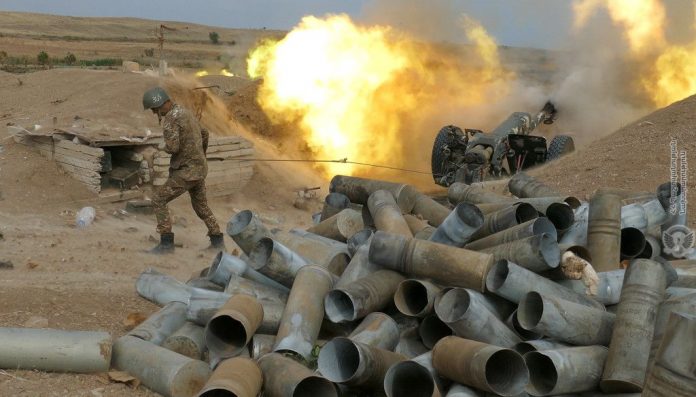Nagorno-Karabakh has taken international visibility in the recent months, with renewed clashes in the disputed region. Reports have highlighted that more than 500 people have been killed in the last month, with escalation of the conflict. The ethnic strife between Armenians and Azerbaijanis first took prominence with the Sumgait pogroms of 1988, which resulted in hundreds of killings of Christian Armenians. It developed into one of the most violent ethnic conflicts during the Gorbachev years with millions of refugees stranded on the Azerbaijani side. Hence, the conflict of Nagorno-Karabakh requires studying. A historical understanding of this ethnic strife is instrumental in making sense of the current events unravelling in the Caucasian States.
Like any other ethnic violence, the issue of Nagorno-Karabakh had its roots in “fear.” Fear of being dominated by the “other.” This construction of “otherization” went on to create a chain of prejudices between Azerbaijan and Armenia alike, about each other’s existence.
Nagorno-Karabakh was an autonomous region of Azerbaijan (SSR). After the Bolshevik Revolution (1917), Soviet Army invaded the South Caucasus. Because of the varied ethnicity of the regions, the Soviets came up with a policy of granting specific autonomy to these ethnic territories. Here, arose the issue of incorporation of Nagorno-Karabakh. The area belonged to the Armenians, according to some ancient texts. And on the other hand, the Azeris considered the region as a centre of Azeri culture founded by Panah Ali Khan in the 1750s.
Historically, Karabakh was first attached to Armenia, but the decision was reversed by Stalin and was added to Azerbaijan instead. By 1923, Nagorno-Karabakh was proclaimed as an Autonomous Region of the SSR of Azerbaijan. In 1988, The Assembly of Nagorno-Karabakh for the first time officially asked the authorities in Moscow to join Armenia. It was not accepted, but it acted as a trigger of violence with Azeris being expelled from Karabakh and the Sumgait pogroms on Armenians. The moment Moscow announced that the transfer request was rejected, the region mobilized for a fight. Protest rallies in the central square of Stepanakert, the provincial capital, got frequent. The demography of the Karabakh region was majorly Armenian, but for Azerbaijan the fear of losing more Armenian land was fuelling their ethnic prejudices.
With such background of ethnic insecurities, the first violence occurred in the Armenian populated village of Chardakhlu in north-western Azerbaijan. An alleged incident made it to the radios, of a party member confronting protesting Armenians, and in that raid some women, children were beaten up. Considering this incident, as an attempt to “cleanse” the region of Armenians, they responded with burning villages of ethnic Azerbaijanis in Karabakh and Armenia. This catapulted a large migration of refugees from both the sides. And this became the seed of violence which were to haunt these two countries in the coming future.
Azerbaijan declared itself independent in August 1991, followed by Nagorno-Karabakh next month. A pro-independence referendum was also held in Karabakh, which was formalized in January, 1992. This was followed by the largest massacre in the conflict, till date. The Khojaly Massacre on Feb., 1992. More than 200 Azeris were killed, with thousands of ethnic Azeris and Armenians stateless.
After a considerable amount of political hustle, a ceasefire agreement was signed between the two countries in 1994. A list of guidelines were accepted by both the parties by OSCE (Organization for Security and Cooperation in Europe) mediators, called the “Madrid principles”. Russia became the prime mediator, and both the presidents jointly discussed the principles in Sochi, in January 2010. Though these principles have just been signed and not ratified by either of the countries.
Russia considers the stability of South Caucasus as instrumental for both its political and economic interest. After the Russian-Georgian war of 2008, Russia had bolstered its influence in the region. The prime rivalry in the Caucasus comes from Turkey, a NATO member. And Russia acknowledges Armenia to be a key piece, in order to regain its influence over the South Caucasus and Central Asia. Turkey on the other hand, has historic ties with Azerbaijan. Though due to its weak economic situation, it did not pay much attention to the Nagorno-Karabakh problem in the 1990s. But with time, the race to gain geopolitical relevance had made its activities in the regional politics quite frequent.
Being such an important region both for European energy projects and infrastructural pipelines, the region has been an international concern for decades. As a conclusion, it is imperative to understand the mass-led character of Nagorno-Karabakh conflict in order to visualize an effective peace process. Cease fire violations have been a reality in every border dispute all over the world. The Caucasus is no different in nature. But the character of ethnic violence being in the backdrop, radicalizing the local population of these countries stand out. Wondering through history these recurrences of violence, be it the Sumgait pogroms or the Baku riots — were not just official actions gone wrong. It was motivated with nationalist ideology and cultural deprivation.
One cannot look at case study of ethnic violence without considering the emotive aspect of perception of fear among the masses. Hence, the Soviet Union’s attempt to give cultural and economic concessions to the factions failed. The problem was not supposed to get resolved with just materialistic concessions. The ethnic prejudice survived. The long standing nationalist ideology and emotional hostility has been the background of the stereotype of Azerbaijanis as oppressors for the Armenians and vice versa. These prejudices have remained among the masses. And hence the peace process has been extremely fragile in the political space.
The views and opinions expressed in this article are those of the author.
Upamanyu Basu is a postgraduate in Political Science from Presidency University, Kolkata, India. He has worked as a Research Assistant with Essex University, United Kingdom. His research interests lie in the field of South Asian History, Migration, and Gender.


